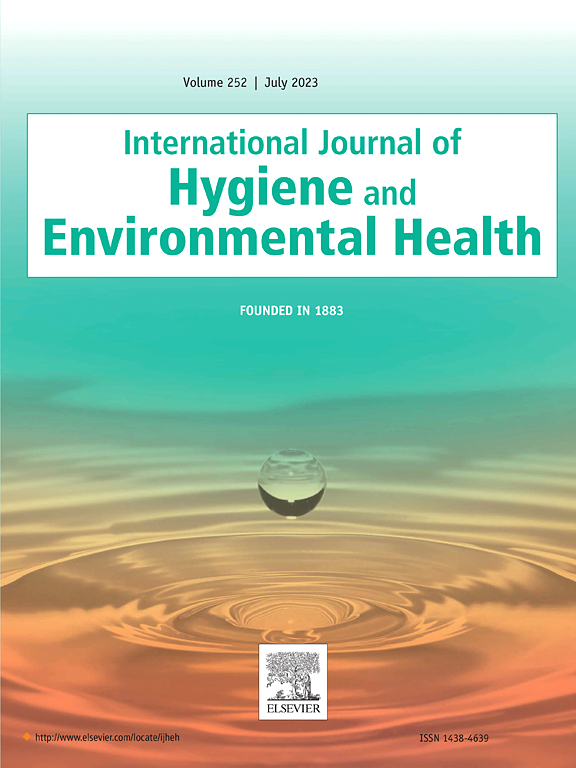农业健康研究中威因的使用和癌症的发生:一项最新分析
IF 4.4
2区 医学
Q1 INFECTIOUS DISEASES
International journal of hygiene and environmental health
Pub Date : 2025-06-28
DOI:10.1016/j.ijheh.2025.114615
引用次数: 0
摘要
威因在美国是一种常见的氨基甲酸酯类杀虫剂。以前的流行病学调查,包括农业健康研究(AHS),已经表明使用西维因与癌症风险之间存在潜在关联。AHS是美国北卡罗来纳州(NC)和爱荷华州(IA)的一项前瞻性队列研究。在入组(1993-1997年)和随访(1999-2005年)时报告了终生农药使用信息。我们评估了与使用西威因的时间和强度加权终生天数(IWLD)相关的癌症风险。在52,625名申请者中,通过2014年(NC)或2017年(IA)与州癌症登记处的联系确定了8713例癌症病例。我们使用泊松回归来估计比率(RR)和95%置信区间(CI),控制混杂因素,并评估滞后暴露。大约51%的施药者报告使用了西维因。西威因使用的IWLD增加与胃癌风险增加相关(三分之一与从未使用;RRT3 = 2.07, 95% CI: 1.05-4.07, p-trend = 0.02),当暴露滞后5年时持续存在(RRT3 = 2.20, 95% CI: 1.12-4.33)。我们注意到长期使用的食管癌(RR = 1.52, 95% CI: 1.01-2.27)和舌癌(RR = 1.91, 95% CI: 0.95-3.81)的风险升高。当西威因暴露滞后30年时,侵袭性前列腺癌的风险增加(RRlag30Q4 = 1.56, 95% CI: 1.18-2.08, p-trend = 0.002)。这是迄今为止对西威因和癌症风险进行的规模最大、最全面的前瞻性评估。我们提供新的证据,证明暴露在西维因和特定癌症之间存在关联。需要进一步的研究来证实这些发现,并阐明所观察到的关联背后的生物学机制。本文章由计算机程序翻译,如有差异,请以英文原文为准。

Carbaryl use and incident cancer in the Agricultural Health Study: an updated analysis
Carbaryl is a common carbamate insecticide in the United States (USA). Previous epidemiologic investigations, including within the Agricultural Health Study (AHS), have suggested potential associations between carbaryl use and cancer risk. The AHS is a prospective cohort study of licensed pesticide applicators in North Carolina (NC) and Iowa (IA), USA. Information on lifetime pesticide use was reported at enrollment (1993–1997) and follow-up (1999–2005). We evaluated cancer risks associated with ever- and intensity-weighted lifetime days (IWLD) of carbaryl use. Among 52,625 applicators, 8713 incident cancer cases were identified from linkages with state cancer registries through 2014 (NC) or 2017 (IA). We used Poisson regression to estimate rate ratios (RR) and 95 % confidence intervals (CI), controlling for confounders, and evaluated lagged exposures. Approximately 51 % of applicators reported using carbaryl. Increasing IWLD of carbaryl use was associated with increased stomach cancer risk (third tertile vs. never use; RRT3 = 2.07, 95 % CI: 1.05–4.07, p-trend = 0.02), persisting when exposure was lagged by 5-years (RRT3 = 2.20, 95 % CI: 1.12–4.33). We noted elevated risks of esophageal (RR = 1.52, 95 % CI: 1.01–2.27) and tongue (RR = 1.91, 95 % CI: 0.95–3.81) cancers with ever-use. There was an increased risk of aggressive prostate cancer when carbaryl exposure was lagged by 30 years (RRlag30Q4 = 1.56, 95 % CI: 1.18–2.08, p-trend = 0.002). This is the largest and most comprehensive prospective evaluation of carbaryl and cancer risk to date. We provide novel evidence of associations between carbaryl exposure and specific cancers. There is a need for additional studies to confirm these findings and to elucidate the biological mechanisms underlying the observed associations.
求助全文
通过发布文献求助,成功后即可免费获取论文全文。
去求助
来源期刊
CiteScore
11.50
自引率
5.00%
发文量
151
审稿时长
22 days
期刊介绍:
The International Journal of Hygiene and Environmental Health serves as a multidisciplinary forum for original reports on exposure assessment and the reactions to and consequences of human exposure to the biological, chemical, and physical environment. Research reports, short communications, reviews, scientific comments, technical notes, and editorials will be peer-reviewed before acceptance for publication. Priority will be given to articles on epidemiological aspects of environmental toxicology, health risk assessments, susceptible (sub) populations, sanitation and clean water, human biomonitoring, environmental medicine, and public health aspects of exposure-related outcomes.

 求助内容:
求助内容: 应助结果提醒方式:
应助结果提醒方式:


